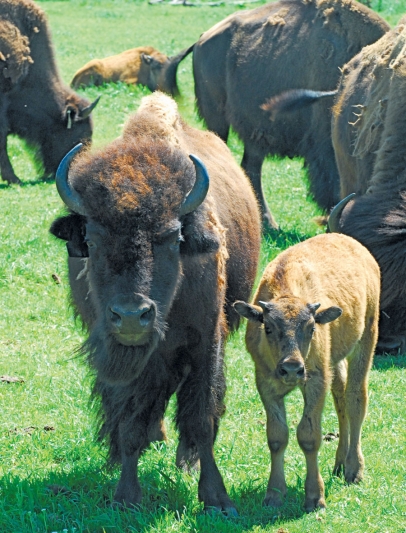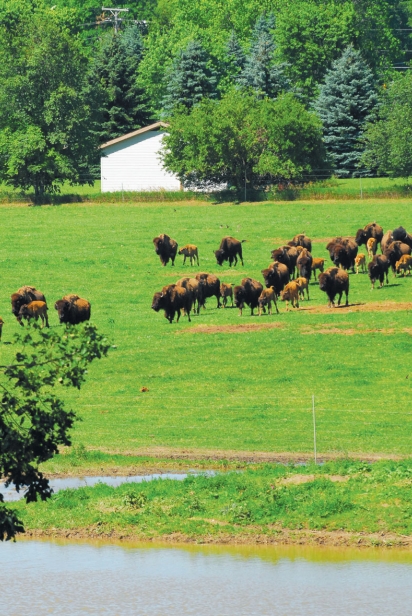Buffalo Roaming through the Empire (State)
American bison are icons of a lost age of free-range innocence, wildness and purity. We were reminded in April of the reason they have become such a rare sight: When a small herd of 15 bison escaped from GEM Farms in Castleton and roamed over town border lines, through the Hudson River and even crossed Interstate 87, it was a stark reminder of just how helpless human beings are when faced with these magnificent ungulates. (The herd escaped from GEM when a falling tree damaged a fence on their pasture.)
Since there was no way to tranquilize or contain the animals, authorities recruited hunters to help bring them down, eventually shooting them dead in Bethlehem. Despite reaching out to GEM Farm for insight into the tragic day and their plan moving forward, they did not return calls. The farm’s aversion to publicity is understandable: Following the April incident, Albany County Sheriff Craig Apple reportedly received death threats, and he acknowledged later that instead of having hunters shoot the animals, he should have had members of the county’s Animal Response Team kill them. Adding to the overwhelming sense of waste and sadness, the bison meat could not be sold because it was not inspected, though it was distributed to people involved in the removal and cleanup of the herd’s carcasses.
The degree of attention the escaped herd received (hundreds of articles in newspapers across the country covered the story, and citizen journalists took to Twitter, Facebook and Instagram in droves to publish snapshots of the animals) underlines our general fascination with bison. While meat consumption in America is still high (about 270 pounds per person a year), consumers are increasingly interested in getting their meat from responsible sources, and companies are responding.
Hormel Foods Corp., aka the maker of Spam, just scooped up Applegate Farms for $775 million, its biggest purchase ever. The deal gives Hormel a foothold in the natural and organic meat department, an area it sees as “a movement, not a fad,” chief executive Jeffrey Ettinger said when the deal was announced.
Heck, even McDonald’s is limiting the use of antibiotics in its chicken.
Many consumers are no longer willing for animals to pay the price for cheap meat, and in addition to pressuring large corporations to act more responsibly, people are turning to non-beef, non-chicken and non-pork alternatives. The tragedy of the GEM herd’s death underlined how much we have to learn about bison, North America’s largest land animal.
It’s easy to underestimate these creatures: Despite their lumbering, romantically slovenly appearance, bison are wild animals, capable of deliberate or accidental harm to their human caretakers. Bison cannot be tamed or controlled like other livestock. However, their warm pelts, delicious meat, sturdy bones and inherent wildness have always attracted humans.
Native Americans hunted bison for food and pelts, never for mere entertainment. Before the 1500s, roughly 30 to 60 million bison roamed North America’s plains and prairies. However, starting in the 1800s European hunters began to slaughter bison by the millions for both fun and profit, drastically reducing the total population to 325 wild bison by 1884.
Slowly, thanks to intervention from Congress and the Army, herds were re-established in Yellowstone National Park, on private land in Texas and elsewhere. Currently, bison number about 220,000 in the U.S., according to the National Bison Association.
In addition to being beloved as a symbol of an earlier era, many people turn to bison meat for its nutritional profile and taste. Bison is one of the healthiest dining options for carnivores, especially redmeat lovers. Bison provides the flavor and succulence of beef, without the cholesterol and fat. At just over 100 calories, 1.35 grams of fat, 21 grams of protein and 3 milligrams of protein per 100 grams, bison meets or exceeds the nutritional profile of beef, poultry and pork.
Bison, by nature, require space to roam and avoid human interaction, making the cramped quarters, unsuitable feed and hormone or antibiotic injections prevalent in many other meat-production facilities impossible. Because bison move and graze so intensely, they create new, strong locations for the seeds of prairie plants to germinate, resulting in a diverse, rich atmosphere for pollinating insects and birds.
And for locavores, there are a number of small bison herds in New York State, all of which sell to the public, though most require an actual stop at the farm. Not that anyone complains about a delicious excuse to take the scenic route from ranch to plate. A few of our favorite ranches within reach of the Capital District:
Adirondack Buffalo:
The Adirondack Buffalo Company, nestled in the Adirondack Mountains in North Hudson, has become a favorite destination for bison meat lovers and families who just want an excuse to wander through the inviting gift shop, meadows and hills, for a glimpse of the 40-member herd. Doreen Ossenkop, co-owner with her husband, Steve Ossenkop, says that their 25 years with the bison have been inspiring and challenging.
“They truly are wild,” Ms. Ossenkop says. “Humans can’t handle them. Vets won’t go near them. You just make sure they’re fed and watered and leave them alone, even in the winter. Their fur is two-and-a-half times thicker than cattle’s, so snow doesn’t melt on them. It just sits on their fur until the sun melts it.”
Their elusive nature isn’t an issue for the Ossenkops—until there’s a problem with a pregnancy. “There have been a few terrible breech births over the years,” Ms. Ossenkop remembers. “That’s the hardest. When they’re sick or in pain and you know it, there isn’t a thing you can do. You can’t give them sedatives because that can kill them. Once we did have to sedate a mother, though, because it was clear she was going to die and we wanted to save the calf at least.”
The notion of saving and using every salvageable part of the herd underlines every decision the Ossenkops make. Before an animal is slaughtered, they try to line up people who can use the head and hide, in addition to the 500 pounds of meat each animal can be expected to produce.
Barefoot Buffalo Farm:
“The motto of the National Bison Association is ‘You can herd a bison anywhere it wants to go,’” laughs Amy Weakley, who owns the Barefoot Buffalo Farm located in Taberg. “Even though we have telephone poles as posts and fences that are eight feet high, if they wanted to get through, they could. We just keep them happy, and they seem to think that the fence protects them from us.”
It’s not just clueless consumers who are entranced by bison, it seems. Watching the bison cavort and interact has become more rewarding for Ms. Weakley and her family than anything else they do on the farm, she says.
“I love seeing how their personalities and traits come out over time,” she reports. “Bison are matriarchal, and one mother in particular is very aggressive to other bison and humans, but all of the babies are drawn to her. She does most of the calf-rearing in the herd. There’s another one that we call Inspector because she’s so curious. Whenever we’re out, she comes up to the fence to see what we’re up to.”
Another benefit to owning a bison ranch, of course, is the meat. “My favorite cut depends on my mood,” she says. “There’s nothing like a rib eye or tenderloin for a special occasion, but a roast with the family is great after a long day. The weirdest thing I do with it is make cheeseburger bread—my kids love it.”
The Weakleys also prioritize hoof-to-pelt usage, going so far as to even try to find a home for the bison’s innards. “We have had science teachers who have requested lungs, the heart and the esophagus. We were thrilled to pass them along!”
Consumers heading to the farm to buy meat should call ahead for hours and directions. BarefootBuffaloFarm.com
Bison Island:
Bison Island Farm in Cobleskill was launched directly from the palate (and the heart).
“My wife, who wasn’t yet my wife, Susie, and I were on a trip to Chicago to visit my father,” Brian Grubb, co-owner with his nowwife, explains. “We went to Harry Caray’s, and she had a bison fillet and said it was the best thing she’d ever tasted. A few days later, we visited my dad’s farm and I mentioned he had a small herd of buffalo. Well, she saw them and fell in love. A few weeks later, we were visiting her father and I saw a real estate ad for farmland. One thing led to another, and a few weeks after that, we were under contract for a bison farm!”
That was 2011. Just four years later, they have a booming business with only one problem: supply.
“We can only produce so much on our 300 acres,” Mr. Grubb says.
While basing a decision to mix North America’s largest land mammal, a new marriage and a big financial investment on a delicious meal in Chicago may seem like a dicey prospect, they “definitely made the right decision,” Mr. Grubb says. They currently have 110 head of bison. Bison Island, like the other bison farms we spoke with, tries to be “as sustainable as possible,” he says.
“It takes a lot of resources to produce grain, and having a grass-fed product like bison not only tastes better, but is better all around,” Mr. Grubb says.
Bison Island currently sells at the farm, at some area farmers’ markets (it varies depending on the season) and, as of June, online. Mr. Grubb, like his wife, loves a good steak, but is also a fan of their kielbasa, sausages and snack sticks.
Bison Island is at 191 Gardnersville Road in Cobleskill, 307-699-0595.
Hungry but in need of inspiration?
The Bison Council has hundreds of imaginative recipes on its site, BisonCouncil.com.
Hungry, but unwilling to cook?
Head to Henry Street Taproom at 86 Henry Street in Saratoga Springs.
“We have bison on the menu,” Maria Mendez, the chef at Henry’s, says. “I personally love the delicious flavor, and a lot of our customers love how healthy it is. I’ve made everything from meatballs and hamburgers to lasagna to pasta sauces with it. I change the dishes seasonally, but you will always find bison on our menu.”
Bison Facts:
• The terms “buffalo” and “bison” are used interchangeably and are also both widely accepted. The name “buffalo” is thought to have derived from European settlers who probably thought American bison were African buffalo or Asian water buffalo. While all three animals share common ancestors, they evolved differently. Technically, the correct name is American bison. Bison are five- to six-and-a-half-feet tall and weigh between 701 and 2,205 pounds in the wild.
• Bison of both sexes have curved horns that can grow up to two feet long.
• Bison will live between 15 years in the wild and up to 25 in captivity.
• 9 months: length of pregnancy for bison.
• 50 million: roughly the number of bison killed in America during the 19th century.
• 220,000: bison in America on preserves and ranches.
• Bison can run up to 40 miles per hour (faster than a horse).
• Bison herds are matriarchal.
• Bison eat mostly grass (hay in the winter in New York).
• Bison display moods through their tail positions.





